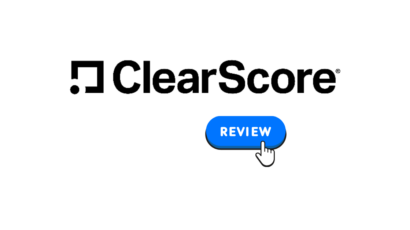Disclosure: Privacy Australia is community-supported. We may earn a commission when you buy a VPN through one of our links. Learn more.
Top 10 Best Internet Providers in Australia for 2024
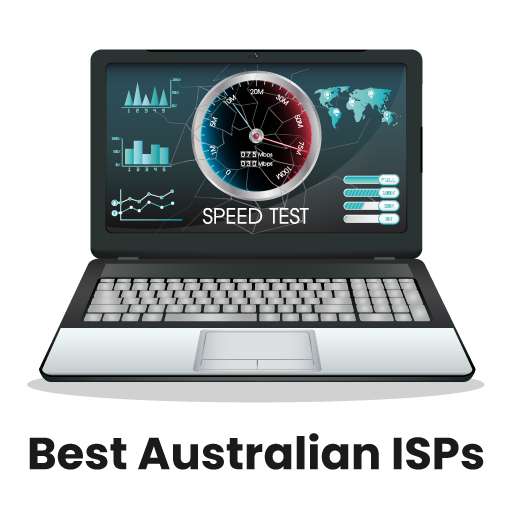
At Privacy Australia, we spend a lot of time online. Diving deep into research and engaging with the community, leaves us understanding how important a reliable internet connection is. We also recognize we’re not alone in our quest for the best internet provider Australia. This is why we set out on a mission to find the top 10 internet providers for Australian Customers.
When choosing the business phone service providers on this list, we considered a number of important factors. These include details like price, features, reliability, scalability, and more. Let’s see how they compare best.
Table of Contents
- TL;DR
- Criteria Breakdown Summary
- Aussie Broadband
- Telstra
- Optus
- TPG Telecom
- iiNet
- Vodafone
- Dodo
- Exetel
- Belong
- Superloop
- Notable Mentions
- Frequently Asked Questions
- Final Thoughts
TL;DR
- Aussie Broadband offers the best overall package with top-notch speeds and customer service.
- Telstra provides the widest coverage but at a premium price
- TPG and Dodo are solid budget-friendly options
- Consider factors like speed, data allowance, and contract terms when choosing a provider.
- Always check availability in your area before committing to a plan
Criteria Breakdown Summary
When evaluating internet providers in Australia, we focused on a set of 8 criteria. We chose these 8 because they represent performance and value while placing all providers on a level playing field.
- Coverage and availability
- Speed tiers and real-world performance
- Data allowances
- Pricing and value
- Customer service quality
- Contract flexibility
- Additional features and perks
- Network reliability
With each criterion, we used a numerical scale of one through five, with five representing the strongest performance. Now, let’s dig in to find the best internet provider Australia offers.
Aussie Broadband
Best Known for Superior Customer Support
Aussie Broadband was founded in 2008, and since its inception has become a favourite among Aussie internet customers. Aussie Broadband’s performance is strong across the board, but what really caught our attention is its commitment to customer support.

Aussie Broadband’s customer support team is 100% Australian-based, meaning they understand pain points and regional challenges with internet connections. In line with Aussie Broadband’s customer support is their transparency on network capacity. Let’s look at the features that make Aussie Broadband stand out.
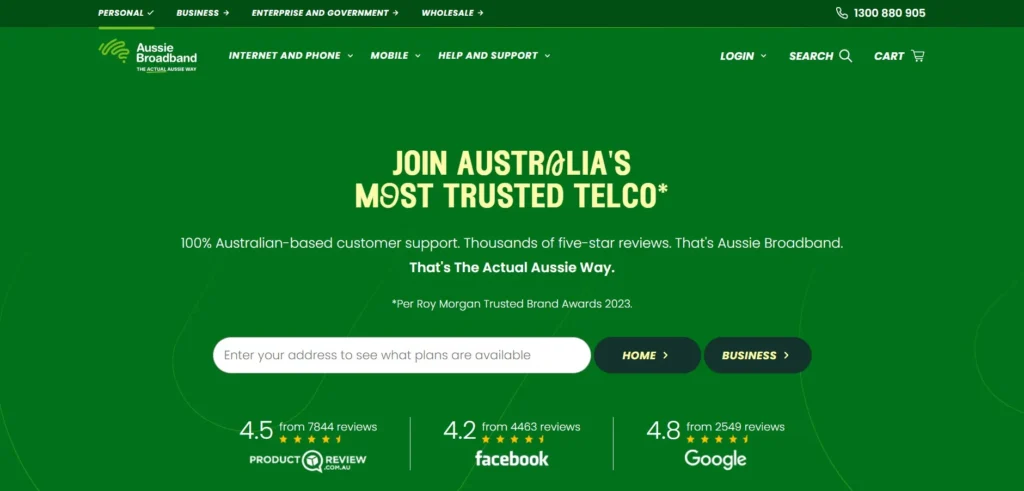
Features
My Aussie App: Aussie Broadband offers an intuitive app for customers to manage their accounts. From monitoring usage to keeping track of maintenance, this is the easy-to-use command centre for Aussie Broadband.
No Lock-In Contracts: We appreciate that Ausse Broadband offers no lock-in contracts. There are no fees or complicated processes when cancelling, regardless of the reason. Why does Aussie Broadband offer this advantage? They feel their service is good enough to keep customers without locking them in a contract. Award-Winning Customer Service: Aussie Broadband has received accolades for its customer service. With awards from Canstar, Choice, Roy Morgan, and Mozo, there’s a level of confidence in its support team.
Pros
- Consistently high speeds even during peak hours
- Excellent, Australian-based customer support
- Transparent about network capacity and issues
- Flexible plan options with no lock-in contracts
Cons
- Slightly higher prices compared to budget providers
- Limited bundle options for additional services
- Coverage may be limited in some rural areas
Criteria Evaluation
- Coverage: 4.5/5
- Speed: 5/5
- Value: 4.5/5
- Customer Service: 5/5
- Reliability: 5/5
Community Reviews and Expert Recommendations
We’re going to begin our exploration of Aussie Broadband reviews by mentioning the awards it has received. As an Internet provider in Australia, it has been named “Internet Service Provider of the Year”. Along with this are the “Roy Morgan Best of the Best Award”, and “ProductReview Internet Service Provider Award”, among others. To drive home the level of service, it received an impressive 88% score, winning the CHOICE Best Brand NBN award.
While there are occasional negatives in the Aussie Broadband community, these appear to be exceptions rather than the norm. The community has pointed out less congestion compared to other internet providers in Australia. For customer service, Aussie Broadband has been praised for quick resolution times, especially with technical issues. Additionally, experts in the industry give Aussie Broadband props for its overall network management practices.
Pricing
Plans begin at $79 per month for the Basic Plus plan. If it’s in the budget, it’s honestly better to spend a bit more for the Fast plan at $85 per month. The service difference between them is exponential. Basic is 25/10, Fast is 100/20 Mbps. Ultra Fast 1000/50 plans are also available at $119 per month. Keep in mind that this pricing may reflect promotional discounts, so pricing at the time of signing up may vary. We encourage you to visit Aussie Broadband for current pricing.
Telstra
Best Known for User-Friendly Interface
In our internet comparison, we’ve named Telstra as the best internet provider in Australia in terms of network coverage. Telstra offers the broadest network coverage in the country without sacrificing speed. Telstra network is built from a mix of FTTP, FTTN, HFC, and wireless technologies for its NBN services. Additionally, 5G home internet coverage is offered in some areas.

For Aussies that reside in more remote regions, Telstra is one of the best for reliable coverage.

Features
NBG, 5G, and Satellite Service: Telstra customers have a choice of NBG, 5G, or satellite internet service. This allows more flexibility in costs and choosing the level of coverage needed.
Telstra Smart Modem: Telstra offers what we’ve seen labelled “Next level home wi-fi” with its smart modem 3. Our research tells us that this modem is consistently faster and more reliable compared to previous versions. The Telstra Smart Modem supports up to 12 streaming devices simultaneously. This is a great modem for families or roommate scenarios.
Telstra Entertainment Services: One of Telstra’s perks is its expansive options for entertainment services. These include BINGE, Disney+, Spotify, Kayo, Slash, and Xbox, among others. While not exactly entertainment-related, Telstra does offer the option for McAfee Telstra Device Security. We’ve found there is usually a promotional offer available for three free months.
Pros
- Widest network coverage in Australia
- Reliable service with 4G backup on NBN plans
- Bundled entertainment options and smart home features
- Strong 5G network for mobile broadband options
Cons
- Higher prices compared to most competitors
- Customer service can be hit or miss
- Long wait times for technical support
Criteria Evaluation
- Coverage: 5/5
- Speed: 4.5/5
- Value: 3.5/5
- Customer Service: 3.5/5
- Reliability: 4.5/5
Community Reviews and Expert Recommendations
In our commitment to transparency, we must be honest and say community reviews for Telstra are mixed. There are a number of disgruntled customers, so we considered this with our own experiences and conversations with Telstra users.
On a positive note, Telstra customers are overall pleased with speed and coverage in more rural areas. This is definitely an area where Telstra shines. Complaints seem to centre more around faulty equipment and customer service challenges than the service itself.
From an expert point of view, Telstra performs strongly for consistent delivery of service and speed, even during peak times. Telstra’s expansive network is a plus and signals that it will continue to be a reliable internet provider into the future.
Pricing
Telstra’s plans start at $85 per month for 5G internet at 317/36 Mbps. Basic NBN begins at $89 per month with speeds of 24/4 Mbps. Premium plans with faster speeds are priced at $100 or more depending on the plan level. To learn more about Tesltra’s pricing and promotional offers, visit them at Telstra.
Optus
Best Known for Extensive Integration Options
Each of the biggest internet providers in Australia has an area of performance where they really stand out. For Optus, there are actually two features that caught our attention – its entertainment bundles, and competitive pricing structure. It’s often a case of either/or with entertainment and pricing, but not with Optus.

They’ve made significant strides in improving the network infrastructure, allowing for improved performance consistency, while not jacking up its pricing. Optus almost always has exceptional deals on internet bundles, making it one of our top choices for streamers and gamers.
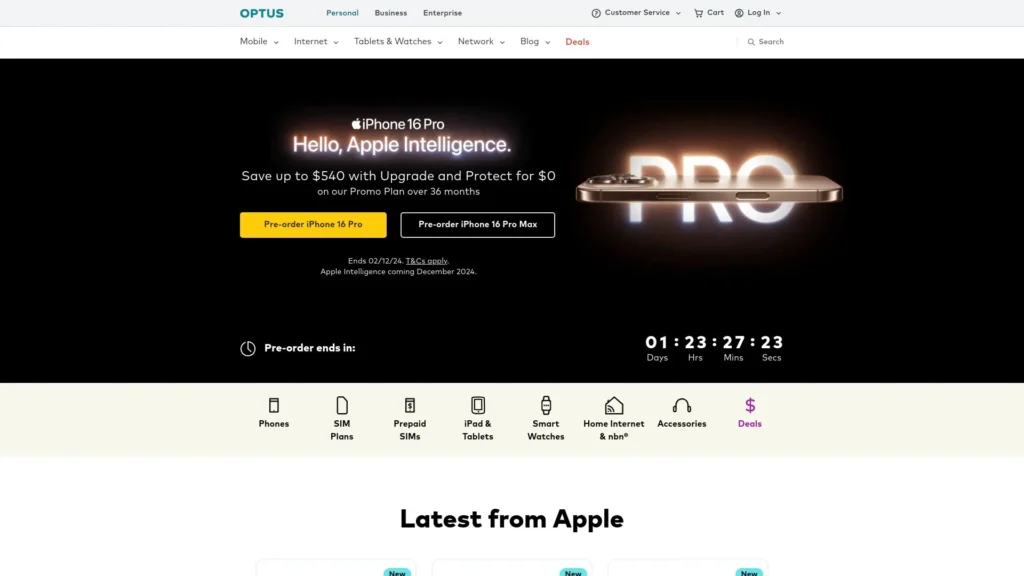
Features
Netflix Included in Most Plans: Where other Australian internet providers charge a fee for additional streaming services, Optus includes Netflix in most of its plans.
Wi-Fi Secure Feature: Optus partnered with McAfee to offer Wi-Fi Secure. This is a feature that protects every device that is connected to a home modem. Wi-Fi Secure blocks malicious websites and attempts to access malicious devices. This covers more than computers and smartphones. It also covers susceptible devices like baby monitors and home smart locks.
Optus Plus Family Entertainer NBN Plan: Includes 4K streaming, Netflix subscription, access to Optus SubHub and Living Network, and Wi-Fi Secure.
Pros
- Competitive pricing on most plan tiers
- Strong focus on bundled entertainment options
- Improving network performance and reliability
- Good value for sports fans with Optus Sport inclusion
Cons
- Customer service can be inconsistent
- Some users report issues with peak-hour congestion
- Limited customization options for plans
Criteria Evaluation
- Coverage: 4.5/5
- Speed: 4.5/5
- Value: 4/5
- Customer Service: 3/5
- Reliability: 4/5
Community Reviews and Expert Recommendations
Let’s begin with the positive talk about Optus. First, its broadband performance rating is excellent, typically meeting its advertised speeds. Customers view Optus as a decent value for the money, especially considering perks like Netflix and Wi-Fi Secure. Plus, recently, Optus has made significant improvements to its network, enabling the provider to offer more extensive and reliable coverage.
In our opinion, Optus offers a good middle ground for households with heavy streaming and gaming needs. However, not all reviews are positive. Optus customer support has taken some hits in the online community and has frankly tanked its reputation among online review sites. We’re aware that people are more likely to leave a review when dissatisfied, so we did take this into consideration. Still, the poor customer service reviews are worth considering.
Pricing
Optus offers fairly competitive pricing. We appreciate how they allow customers to choose their own speed preferences within each plan. For example, the Optus Plus Family Entertainer Plan starts at $94 per month with 50Mbps. Customers may also choose 100, 245, or 780Mbps, based on their needs. The most robust Optus Plus Family Entertainer Plan with 780 Mbps is currently priced at $119 per month. For current pricing on all plans, visit Optus.
TPG Telecom
Best Known for AI-Powered Features
We understand the frustrations of choosing between breaking the bank for reliable service or choosing a subpar option. TPG Telecom is our choice for budget-friendly internet plans, without sacrificing quality of service. While it’s true the fancier bells and whistles are lacking with TPG Telecom, the basics are there and they’re solid. This includes speed and reliability of service.

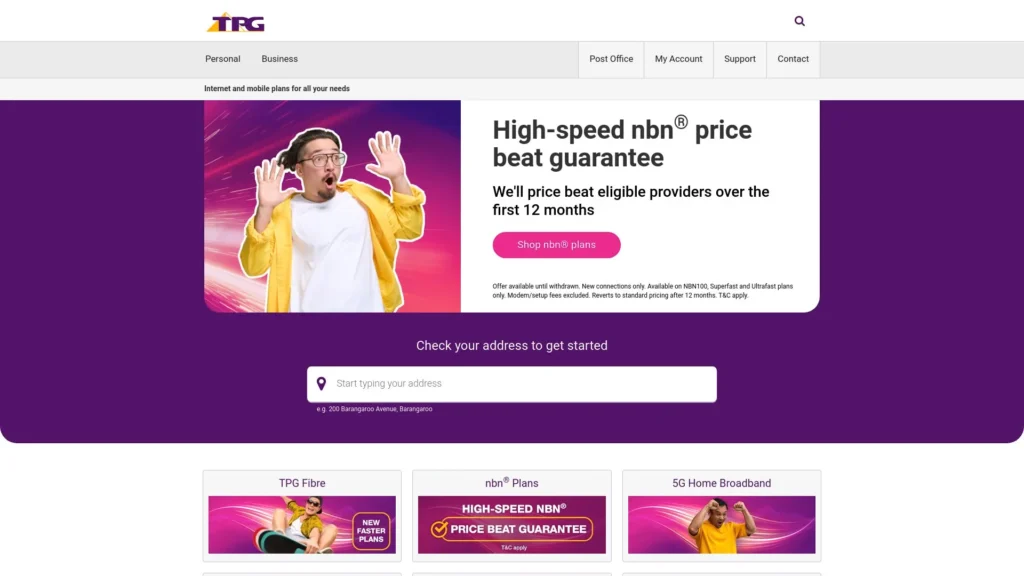
Features
Best Price Guarantee: TPG Telecom is so confident in its pricing structure that it offers the best price guarantee. Find a better price on a comparable high-speed NBN plan and TPG Telecom will beat it. We appreciate how this allows customers to get the best value without needing to change providers.
High-Speed Wi-Fi Modem Included: Don’t have a modem? No problem. With TPG Telecom, customers receive a zero-charge high-speed Wi-Fi modem with a six-month contract.
No Lock-In Contract: For Australian internet customers who have no interest in signing a contract, we’ve noted that TPG Telecom has no lock-in contract plans available.
Pros
- Very competitive pricing across all speed tiers
- A no-frills approach keeps things simple
- Reliable performance for the price
- Flexible contract options
Cons
- Customer support can be slow to respond
- Limited additional features compared to premium providers
- Some users report peak-hour slowdowns
Criteria Evaluation
- Coverage: 4/5
- Speed: 4/5
- Value: 4.5/5
- Customer Service: 3.5/5
- Reliability: 4/5
Community Reviews and Expert Recommendations
We’re noticing a trend with internet provider community reviews. They are almost always highly mixed, with multiple complaints about customer service. TPG Telecom is not an exception. Some customers have experienced frustrations with long wait times and unsatisfactory resolution. However, the affordability combined with performance provides the exact type of value many customers are looking for.
Canstar Blue has rated TPG Telecom a 4-star internet provider in Australia for customer satisfaction. We agree with industry experts who recommend TPG Telecom to customers who prioritise budget-friendliness and don’t need premium features.
Pricing
For rock bottom lowest prices, the most affordable plan we found was the Home Wireless Broadband Plan with Unlimited Data. This plan offers speeds of 15/2Mbps, with plans starting at $54.99. Although, in our experience, there is almost always a discounted introductory price offer for the first six months. NBN Unlimited Data plans start at $69.99 per month and go up to $104.99 per month for the fastest speed of 800/40Mbps. For more information about TPG’s pricing structure, visit them at TPG.
iiNet
Best Known for Strong Customer Service
iiNet is one of the few internet companies in Australia with a positive reputation for customer service. The iiNet team is committed to caring for its customers and providing fast, efficient resolutions. For Australian internet customers who may need more support with technical issues, iiNet is one of the best internet providers.

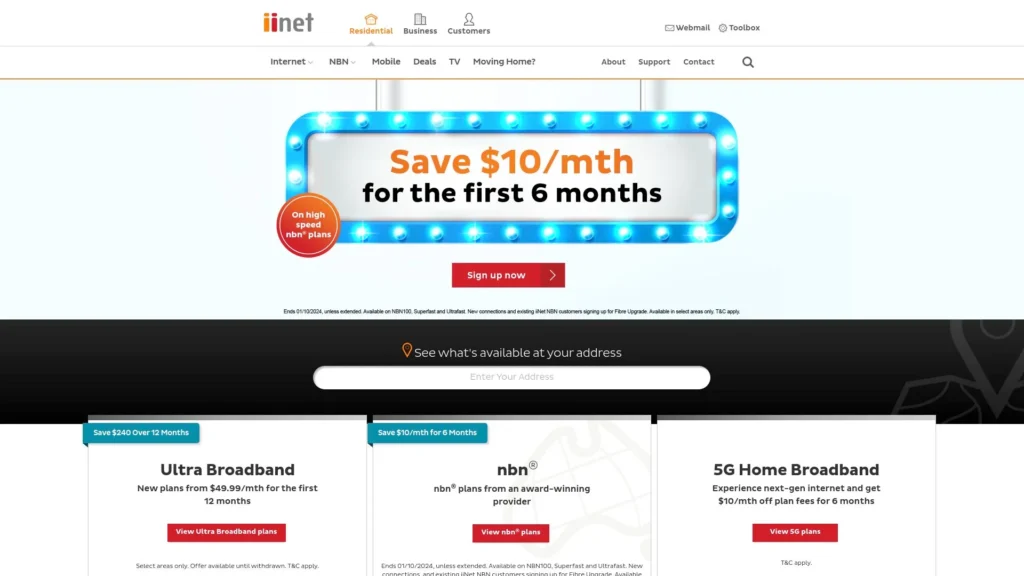
Features
Fetch TV Bundles: iiNet offers its Fetch Mini 4k bundle at zero cost for the first 24 months. This includes the setup box, Netflix, Prime Video, Disney+, and YouTube streaming. Additional add-on bundles are available. A Kids Pack, Vibe Pack, Variety Pack, and Knowledge Pack are all available for just $6 per month.
Modem with 4G Backup: In our internet comparison, we acknowledge how we appreciate internet providers that provide a low-cost free modem. iiNet offers its High-Speed NBN Modem with 4G Connection Backup for free with a 24-month commitment.
Affordable VoIP Add-On Options: As an added feature, VoIP services are available as an add-on at affordable rates with existing plans.
Pros
- Excellent customer support
- Good value for money
- Flexible plan options
- User-friendly account management tools
Cons
- Slightly higher prices than budget providers
- Limited coverage in some rural areas
- Some users report occasional peak-hour slowdowns
Criteria Evaluation
- Coverage: 4/5
- Speed: 4.5/5
- Value: 4/5
- Customer Service: 4.5/5
- Reliability: 4/5
Community Reviews and Expert Recommendations
Industry experts recommend iiNet for its consistently supportive customer service. Note that we say this while acknowledging the customer reviews on sites like Trustpilot don’t always share the same sentiment. Experts mention the company’s helpful support staff, especially for customers who may need a higher level of technical support.
iiNet’s performance ranks high for coming close to its advertised speeds during busy hours, although pricing isn’t as value-friendly as it once was.
Pricing
All iiNet plans feature limitless data. Home wireless broadband starts at $49.99 per month with speeds of 15/2Mbps. NBN plans begin at $69.99 per month for 12/0.8Mbs. The upper tier, NBN Superfast plan costs $89.99 per month with speeds of 250/21Mbps. Details about iiNet’s pricing and plans can be found at iiNet.
Vodafone
Best Known for Mobile Bundle Discounts
While Vodafone is better known as a mobile provider, it is also one of the top internet providers in Australia. As Vodafone has made its way into the broadband market, we’ve seen an impressive improvement in the bundle plans offered. We all need mobile in today’s digital age, and we need the internet too, Vodafone’s bundles mean we can save money while meeting these digital needs.

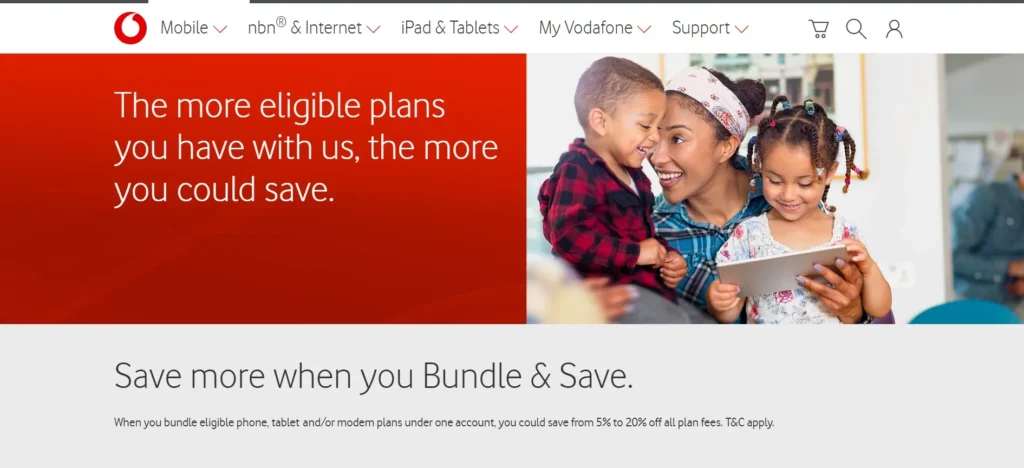
Features
Bundle Discounts: The more plans bundled with Vodafone, the more money saved. Bundle two plans and save 5%. Bundle 3 plans and save 10%. The maximum bundle discount is 20% when bundling 5 plans.
Vodafone 4G Backup: As a way of providing customers with peace of mind, Vodafone offers 4G backup on its NBN plans.
30-Day Network Satisfaction Guarantee: We have firsthand experience in signing up for an ISP, only to realise it wasn’t the best fit. This is why we appreciate that Vodafone offers a 30-day network satisfaction guarantee.
Pros
- Competitive pricing, especially with mobile bundles
- 4G backup on all NBN plans
- Flexible month-to-month contracts available
- A good option for existing Vodafone mobile customers
Cons
- Limited coverage in some regional areas
- Customer service can be inconsistent
- Fewer additional features compared to some competitors
Criteria Evaluation
- Coverage: 4/5
- Speed: 4/5
- Value: 4/5
- Customer Service: 3.5/5
- Reliability: 3.5/5
Community Reviews and Expert Recommendations
In our research, we found Vodafone customers to be very forthcoming in their praise for the internet provider in a few key areas. For example, the bundle discounts have saved Australian internet customers money month after month. The community is also agreeable with Vodafone pricing in general. The simplicity of the pricing model is a plus among customers who are fatigued by complicated plans with hidden fees.
Customer service has left some customers frustrated, but there are an equal number who have had positive experiences. Tech experts are quick to recommend Vodafone Internet for customers who are already signed up with the company’s mobile.
Pricing
Vodafone offers multiple plans to meet its customer’s needs. The lowest rate plan is only $40 per month for 15Mbps. The top-tier account offers 750Mbps for only $100. These prices do not include bundle discounts, which allow for savings from 5% to 20%. Check out Vodafone’s current offers at Vodafone.
Dodo
Best Known for Budget-Friendly Plans
Dodo has a long-standing reputation among the best ISPs in Australia for its affordable pricing structure. This isn’t the only budget-friendly mention on our list, as we’ve already mentioned TPG. However, Dodo’s all-around affordability and value are reason enough for us to include them.

In full transparency, Dodo is best suited for budget-minded customers who need cheap internet. There’s not much in the way of fancy extras with Dodo, but you do get what’s needed – a reliable internet connection.
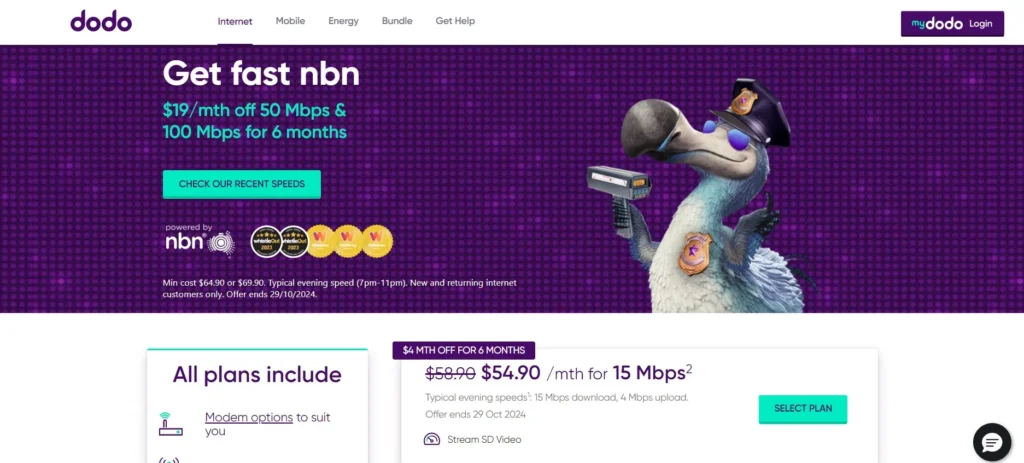
Features
BYO Modem Capabilities: Another way we found to save money with Dodo is to use your own modem. They’ll guide you for setup with their service and there’s no worry about extra monthly charges. However, if a modem is needed, Dodo does offer affordable options.
No Lock-In Contracts: There’s no need to worry about breaking a contract and paying hefty fees as a result.
Unlimited Data: Each Dodo plan comes with unlimited data usage.
Pros
- Very affordable pricing across all speed tiers
- Simple, easy-to-understand plans
- No lock-in contracts are available
- Option to bundle with other utilities for additional savings
Cons
- Customer support can be hit-or-miss
- Limited additional features compared to premium providers
- Some users report peak-hour congestion
Criteria Evaluation
- Coverage: 3.5/5
- Speed: 3.5/5
- Value: 4.5/5
- Customer Service: 3/5
- Reliability: 3.5/5
Community Reviews and Expert Recommendations
To better understand Dodo community reviews, we kept in mind that this internet provider in Australia is all about value. Customers who may have come from ISPs with elevated or luxury features might feel Dodo is lacking. Speed might lag a little during peak times with network congestion, and customer service is hit or miss.
But, they say we get what we pay for, and in the case of Dodo, there’s actually great value for the price. Tech experts are fast to recommend Dodo to budget-conscious users who just need a dependable connection. Dodo has a strong presence in the budget segment of the Australian internet provider market.
Pricing
Dodo NBN plans start at under $55 per month for 15Mbps with an introductory offer. Currently, Dodo is offering an exceptional deal on their faster speed plans, offering 100Mbps for only $69.90 per month. All plans offer unlimited data and easy account management through the My Dodo App. Learn more about Dodo’s pricing at their website, Dodo.com.
Exetel
Best Known for Competitive Pricing and Flexibility
Next on our list of internet provider reviews is Exetel. Known for affordability, we feel Exetel’s flexibility is also worth our attention. Exetel’s pricing structure is competitive with some of the larger, budget-friendly internet providers. What we see Exetel doing differently is taking away the stress of lock-in contracts and fees for switching plans. Accounts can be self-managed through My Exetel.

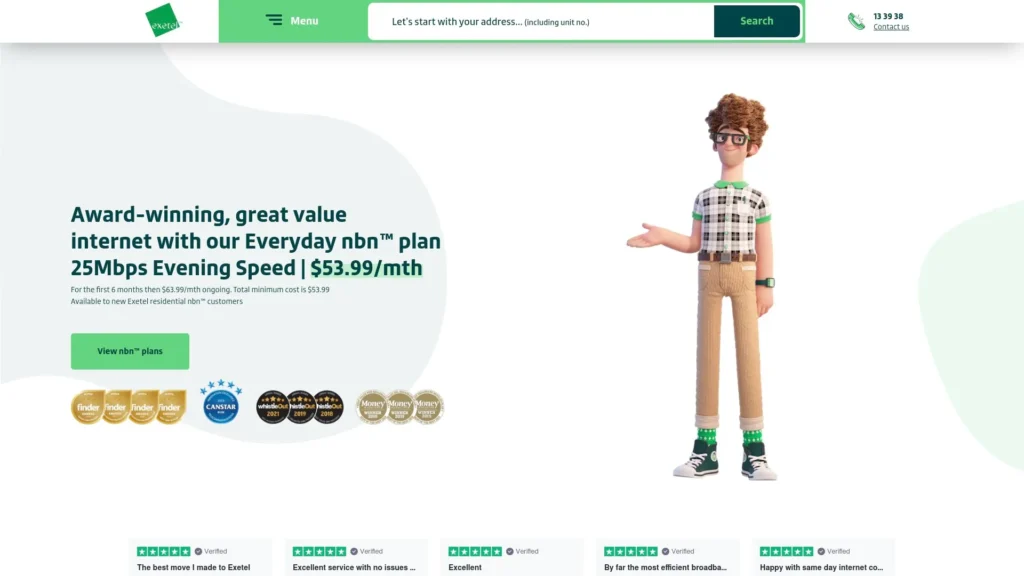
Features
Flexible Plan Options: Exetel is a no-lock-in contract provider. This means customers can come or go as they please, and that plans can be changed without penalty.
Unlimited Data: There’s no need to keep track of data usage, worry about being throttled down, or incur excessive data charges. Data usage is unlimited, all the time. #
Budget-Friendly Unlimited Call Option: For only $10 a month, customers can choose to upgrade to the Unlimited Home Phone.
Pros
- Competitive pricing across all speed tiers
- Flexible, no lock-in contracts
- Good performance for the price
- Simple, easy-to-understand plans
Cons
- Customer support can be slow to respond at times
- Limited additional features compared to premium providers
- Some users report occasional peak-hour slowdowns
Criteria Evaluation
- Coverage: 3.5/5
- Speed: 4/5
- Value: 4.5/5
- Customer Service: 3.5/5
- Reliability: 4/5
Community Reviews and Expert Recommendations
As expected, the Exetel community is fond of the service provider for flexible plans that don’t empty the bank account every month. This combined with decent speeds and reliability leads to community reviews being overall favourable. We have noticed that customer service doesn’t always receive rave reviews. However, many are based on account issues, not service.
From the tech experts, we hear that Exetel is a good value among internet providers in Australia. The features are a bit more robust than services like Dodo, so there’s less of a “bare bones” feeling. However, customers who are accustomed to luxury ISP service might feel a little letdown.
Pricing
Plans start as low as $63.99 per month with 50/20 speed. Exetel’s most expensive option is the Super Fast plan at $83.99 per month with speeds of 250/25. Exetel’s plans can be found at the Exetel website.
Belong
Best Known for Microsoft 365 Integration
We’ve covered the best internet providers in Australia for value, flexibility, entertainment, plan bundling, and customer support. Next, we focus on sustainability with carbon-neutral plans. For this, Belong is our top choice. Belong is Australia’s first telco to be certified carbon neutral.

Going beyond carbon offset, Belong has taken extra steps, such as financially supporting environmental groups and being dedicated to a circular economy.
We understand that while internet customers may want more sustainable options, they also want internet that performs. Belong is a subsidiary of Telstra and leverages its network infrastructure for NBN services.
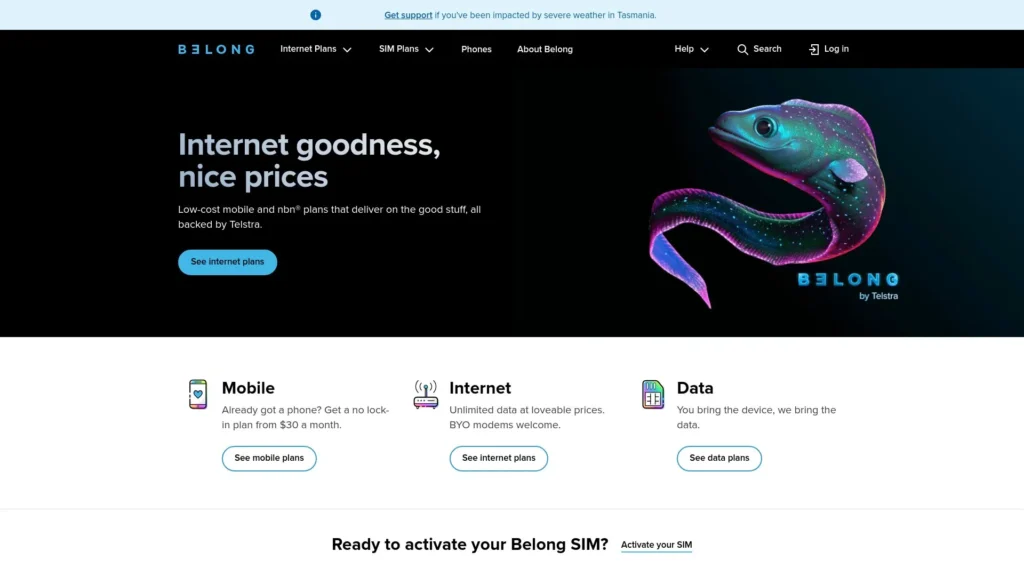
Features
Sustainability Awards: Belong has earned multiple sustainability awards. Among the awards we noticed are “Sustainable Internet Provider of the Year”, “Green Telco of the Year”, and “Green Broadband Provider of the Year”.
Part of Telstra’s Expansive Network Coverage: As a subsidiary of Telstra, Belong offers extensive network coverage, serving parts of Australia that other providers don’t reach.
SIM Card Credit Bonus: New accounts receive a mobile SIM card credit valued at $80 to provide internet access while waiting for NBN service.
Pros
- Competitive pricing on all speed tiers
- Carbon neutral service
- Simple, easy-to-understand plans
- Utilises Telstra’s reliable network infrastructure
Cons
- Limited plan options compared to some competitors
- Customer support can be basic
- Fewer features than premium providers
Criteria Evaluation
- Coverage: 4/5
- Speed: 4/5
- Value: 4.5/5
- Customer Service: 3.5/5
- Reliability: 4/5
Community Reviews and Expert Recommendations
For reliability, speed, and value, Belong receives positive reviews from its user community. Customer service does seem to be a sore point, with frustrations about the lack of resolution. As we’ve previously mentioned, this is a common theme for just about every internet provider in Australia.
From the tech experts comes praise for Belong’s expansive network coverage and straightforward, no-fuss plans. Good transparency and lack of hidden fees are bonus points in Belong’s favour. Experts don’t shy away from recommending Belong to Internet customers who want a more sustainable option and budget-friendly option.
Pricing
NBN plans start at $65 per month for the 25/8Mbps tier. The midrange tier Standard Plus plan is $80 per month for 50/17Mbps. And finally, the 100/17Mbps Premium Plan is priced at $90 per month. Information about Belong’s pricing and sustainability commitment can be found at Belong.
Superloop Plus
Best Known for High-Performance Network
Last, but not least, on our list of the top 10 internet providers in Australia is Superloop. Compared to the other internet providers with substantial longevity on our list, Superloop is only about a decade old. Gaining traction in this industry can be tough, but Superloop has managed to become one of the best, thanks to its high-performance network.

Besides offering NBN services, Superloop also operates its own fibre network. This contributes to its speed and performance, along with advanced traffic management strategies. Even the base-tier plan offers more robust performance than premium plans offered by other providers.
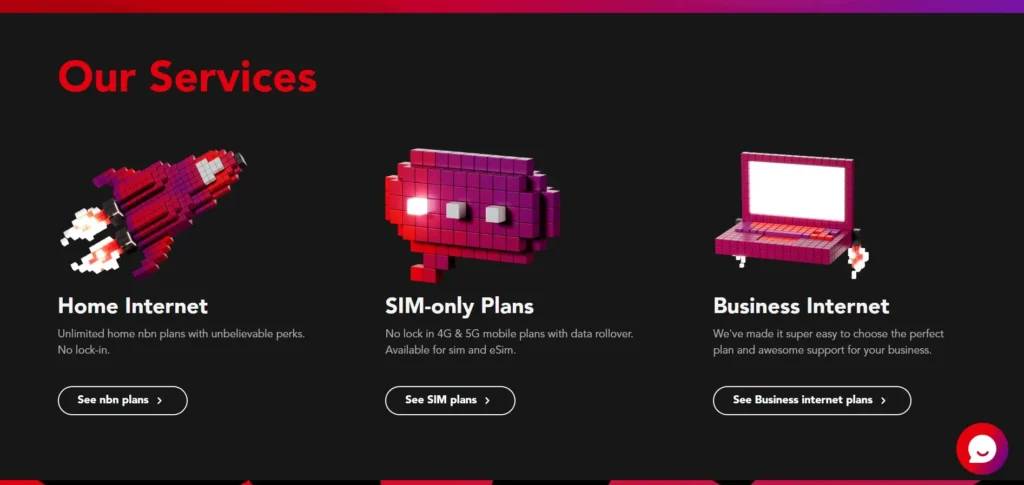
Features
Free Amazon eero6+ Wi-Fi Router: Customers who agree to spend two years with Superloop get a free Amazon eero6+ Wi-Fi Router for superior speed and performance.
Free Speed Upgrade Days: Through My Speed Boost, Superloop customers receive five free speed upgrade days each month. There is a small charge for additional speed upgrade days beyond the limit.
Bundle and Save Options: Superloop offers price discounts for customers who choose to bundle their internet and mobile services.
Pros
- High-performance network with good speeds
- Transparent about network status and performance
- Competitive pricing for the performance offered
- Australian-based technical support
Cons
- Limited coverage compared to larger providers
- Fewer additional features than some competitors
- May be overkill for basic internet users
Criteria Evaluation
- Coverage: 3.5/5
- Speed: 4.5/5
- Value: 4/5
- Customer Service: 4/5
- Reliability: 4/5
Community Reviews and Expert Recommendations
We think we may have found the pot of gold at the end of the rainbow with Superloop. This is one of the few Internet providers in Australia that have received overwhelmingly positive customer service reviews from the community. Our guess is that Superloop’s performance and speed are strong enough to keep their overall customer satisfaction high. Consistent speeds and transparency are often mentioned.
While there are bundling options available, tech experts agree that internet coverage is where Superloop shines. Experts often recommend this provider to customers who prioritise robust speed and a high-performance network.
Pricing
Superloop offers exceptional value with reasonable pricing for high-tier service. While the lowest tier Everyday Plan is $59 for 25/8.5Mbps, we don’t think this is the best deal Superloop offers. Options like the Family plan with 100/20Mbps for only $75 a month is a much better deal. We encourage you to explore all of Superloop’s current plans at Superloop
Notable Mentions
Launtel
For budget flexibility, Launtel is the best option. Customers have the ability to pause their service at any time, and not pay for the day’s service wasn’t used. Launtel can be a great option for customers who don’t use the internet often but still want access when needed.
Leaptel
As an Australian-owned and operated internet provider, Leaptel understands what customers are looking for in terms of customer service. Leaptel is committed to providing the best customer care, combined with high speeds and performance. This provider can be a good option for customers who may need a higher level of tech support.
MyRepublic
MyRepublic appeals to all gamers. They use optimised routing protocols, to practically eliminate latency, leading to smoother performance for gamers.
Tangerine Telecom
We like Tangerine Telecom for its 14-day, risk-free trial and the fact they have no lock-in contracts. A free trial is something we don’t often see among internet providers. This makes Tangerine Telecom feel like a breath of fresh air.
FAQs
What factors should I consider when choosing an internet provider?
The most important factors to consider when choosing an internet provider are coverage, speed, reliability, data allowance, and pricing. We’ve also done enough research to know that customer service performance should also be at the top of the list. When looking for a provider, consider your current needs. For example, other services you want to bundle, or if your household has high streaming or gaming needs.
How do I know which speed tier is right for me?
Choosing the right speed tier is dependent on an individual household’s internet usage habits. For example, some light surfing, watching an occasional video, and checking email daily are typical light use. For this household, the lowest tiers of 25/5 Mbps will likely work just fine. 4K streaming, large file downloads, and active gamers will want a plan with more robust speed, such as 100/20Mbps. Many households fall somewhere in the middle of this range.
Are there any hidden costs I should be aware of?
We’re big fans of internet providers who are transparent with their pricing structure. There’s nothing worse than signing up for a $70 plan, only to end up paying $120 by the time all the fees are added in. When setting up an account, speak with a customer service agent to ensure you understand any extra charges. There might be set-up fees and a charge for modem rental or purchase. Consider if data is unlimited or if there will be added charges at a certain point. Look at contract fees, like early termination fees or fees for changing plans.
What’s the difference between FTTP, FTTN, and HFC connections?
Not all NBN connections are created equal. For example, FTTP offers the best performance with fibre directly to one’s premises. FTTN, which is fibre to node, offers good performance, but speed can be limited. Then there is hybrid fibre coaxial, or HFC. Speeds are generally good, but performance can at times be subpar. Check with your internet provider to determine which types of NBN connections are available in your area.
How important is customer service when choosing an internet provider?
In our opinion, customer service should be a priority when choosing an internet provider. Considering how much of the average person’s life happens online, it’s important to have a reliable customer support team. Ideally, a customer support team should be able to quickly resolve issues and minimise any downtime. Customer service is also a common area of frustration for internet customers. Almost every internet provider has a number of negative customer service reviews.
Final Thoughts
After spending significant time researching and testing internet providers, we’re proud to provide you with this list of the ten best. There is a diversity of options available for Australian internet customers, and we encourage you to research each option thoroughly. Every individual, household, and business has unique internet connection needs. Choosing the provider that best meets these needs will eliminate a lot of frustration further down the road.
At Privacy Australia, we strive to give you the resources and research you need to empower you in the digital world. Whether protecting yourself online, choosing the best internet provider, or connecting with a top online broker, we have you covered. In addition to our best ISPs Australia review, we encourage and welcome you to review some of our other resources.
For example, beginning traders will enjoy How to Start a Shares Portfolio or our Beginners Guide to Derivatives. We also recommend our CMC Markets Review.
We hope this guide has been useful in helping you choose the best internet provider for your needs. Check back with us often and feel free to contact us with questions or comments.




